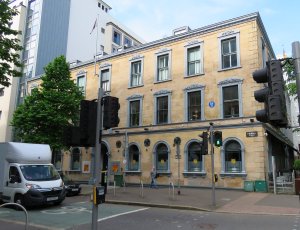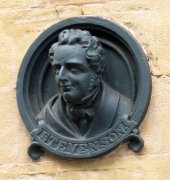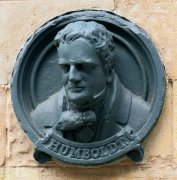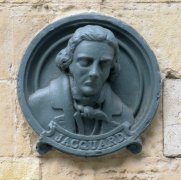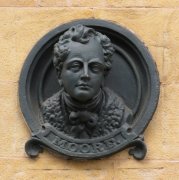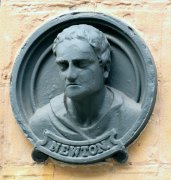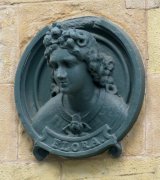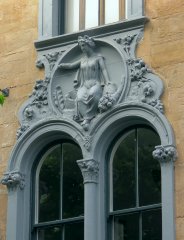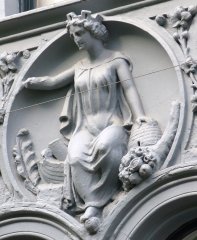Yorkshire House, Linenhall Street, Belfast
Yorkshire House, from Linenhall Street.
One of the roads off Belfast City Square is Linenhall Street, and on the corner is No.10 Linenhall Street, called Yorkshire House, of interest here for its roundels with portrait heads, and one piece of allegorical figure sculpture.
This part of Belfast was built up in the 18th Century, with a boom in linen manufacture, starting with the first linen warehouse in 1830, and reaching a peak from around 1850: a number of these line warehouses survive, repurposed of course, in what is called the Linen Quarter. Yorkshire House, on the corner of Donegall Square South but numbered no.10 Linenhall Street, and now housing a hotel appropriately called Ten Square hotel, was erected in 1862-63, for a company called Jaffe Brothers: a blue plaque nots that Sir Otto Jaffe (1846-1929), Lord Mayor of Belfast and Philanthropist, later had his office here.
Watt, Stevenson, and Humboldt.
The building is three stories high as a rectangular block, with modern dormers set back above so as not to destroy the view from the street. We see a fine sandstone building, loosely Classical renaissance, with minor decorative sculpture on the pediments of the upper floor windows, and the interesting roundels with portrait heads between the arched windows on the ground floor. The building has a similar frontage to the two streets: central door and four bays to each side in an L-shape. The main entrance must be to Donegall Street of course, and there is a double-headed window above it, and the second last bay on the right hand side has a side entrance which also indicates this is the forward looking part. However the frontage to Linenhall Street is hardly less important, the central door having above it the first floor window crowned by our allegorical figure, and again with a side door, this time to the far left.
Jacquard, Moore, and Newton.
The portrait heads run, left to right: Michaelangelo, Columbus, Washington, Mercury, [main door] Minerva, Shakespeare, Schiller, [side door], and Homer – an interesting mix.
On Donegall Street, we have: Newton, Humboldt (he of the penguin), Jacquard (of the loom), Peace, [main door], Flora, Stevenson (the Dublin-born composer), Moore (Dublin-born writer and poet, known for his 'Irish Melodies') and Watt.
Though the building is Classical, the portraits are in the dress of their times, and the pose has them sticking far forward rather than decorously set back in their round frames. This is more dramatic – the faces peer out and down expressively and make a bond with the viewer – but exposes them to the weather, and for perhaps this reason they have been heavily painted, more than once, on occasion white, and on occasion black. Some are therefore in good condition, some worn, a couple poor: Peace has had a botched repair to the weathered face which is a shame, and Newton’s mouth has worn away or had the chin badly replaced. The others retain much detail – note Moore’s keen gaze, woolly outer collar and layers of inner ones and tie, Humboldt’s more flamboyant tie, Watt’s stern gaze below a high forehead, and the eager smile of the sideburned Stevenson. Flora among the Classical heads retains a good Classical roundness of face, and has flowers in her hair and as a central clasp to her cloak. Despite the paint and the wear and tear, these remain good work, above the norm for much architectural sculpture.
Flora.
Up on the first floor to linenhall we have the unnamed allegorical figure, seated, wearing the lightest of clothing, with scrolls and flowers to left and right. She is seated on a boat, representing Trade, one hand resting on a beehive indicating busy Industry – her other hand and whatever it contained is lost – and beside her on the one side is a long feather, perhaps representing Luxury, and on the other a cornucopia, or Horn of Plenty, representing the riches flowing from the business. The scale and the coats of paint limit the detail, but this is a nice composition, and the lines of her body under the thin robe is well captured. If you like allegorical figures, there is an allegorical alphabet on this page, with a few examples of Industry on this page.
Allegorical figure, above Linenhall Street entrance.
For the rest, we may note the pillar head and supporting bracket leafy carving to the ground floor windows, that the first floor decorative carving above the windows has a different motif central to each window, we have a variety of stylised flowers above the windows on the upper floor, and there is a thin band of carved leaves as part of the narrow entablature, if so we might call it.
Flanked by modern buildings of greater height, and with much more impressive architecture on the Square, this quieter Classical building should not be missed.
